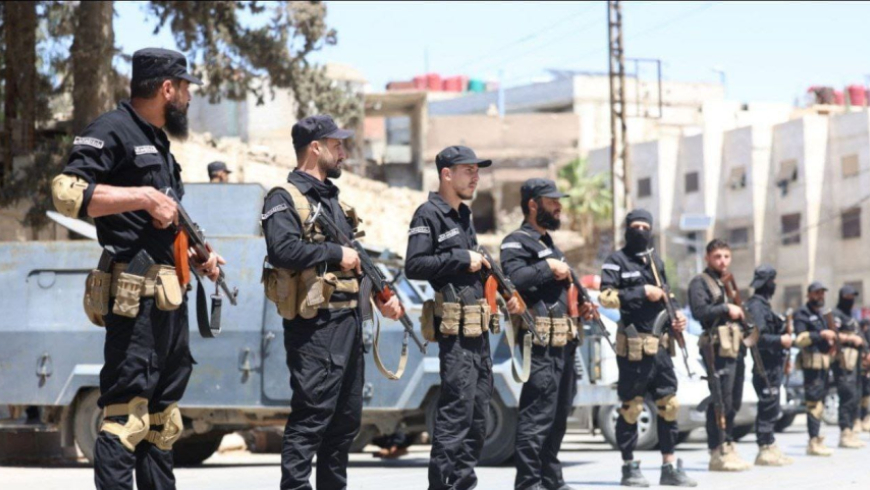The city of Jaramana, on the southeastern outskirts of Damascus, witnessed violent clashes early Tuesday, resulting in at least 13 deaths, including members of the recently established Syrian Public Security Force and local fighters. The violence erupted following the circulation of an audio recording deemed offensive to the Prophet Muhammad, triggering widespread outrage across several cities.
Although Syria’s Ministry of Interior announced the imposition of a security cordon around the city and pledged to prosecute those responsible, the events in Jaramana once again highlighted the fragile communal trust, the proliferation of weapons, and the risks of sectarian incitement in a country still grappling with the legacies of conflict.
From Audio Recording to Armed Clashes
The escalation reportedly began when an audio recording allegedly insulting the Prophet Muhammad spread across social media platforms. Initially attributed to a member of the Druze community, the clip provoked immediate anger, particularly in mixed and Druze-majority areas such as Jaramana and Homs.
The Ministry of Interior later described the recording as “fabricated” and stressed that no confirmed identification of the speaker had been made. Nevertheless, sectarian narratives proliferated online, and within hours, armed men—some reportedly from the nearby Sunni-majority town of Maliha—launched an assault on Jaramana.
Witnesses reported heavy firefights involving light and medium weaponry, including RPGs and mortar fire. The Syrian Public Security Force, a newly created entity composed largely of former combatants from various factions, reportedly lost at least two members during the clashes.
Security Forces Targeted
Local Druze authorities stated that most of the deceased were residents of Jaramana affiliated with the Public Security Force, a claim partially corroborated by the Ministry of Interior. According to the authorities, the victims were ambushed while manning security posts.
While the Ministry insisted that no external attack had occurred, describing the unrest as a spontaneous civilian reaction, local testimonies and footage suggested otherwise. Videos circulated online showed several slain attackers, and heavy gunfire was reported throughout the night, fueling concerns of wider escalation.
Unconfirmed reports mentioned curfews, ambulance blockades, and difficulties in evacuating the wounded due to the intensity of the clashes.
Tensions Spread Beyond Jaramana
The fallout from the recording extended beyond Jaramana. In Homs, tensions flared in university dormitories, with reports of assaults targeting students from Sweida, resulting in at least one death and multiple injuries before security forces intervened.
Demonstrations also broke out in Damascus, Hama, and other areas, with sectarian rhetoric escalating. Armed groups reportedly blocked the Damascus–Sweida highway, firing at vehicles and prompting authorities to issue warnings to avoid the route.
Calls for Calm and Dialogue
In response to the unrest, a meeting of religious, political, and community leaders from Sweida was convened. Participants called for an immediate ceasefire and emphasized the need for dialogue to prevent further communal strife.
Leading Druze religious figures, including Sheikhs Yusuf Jerbou and Hammoud Hanawi, issued a joint statement condemning both the offensive recording and the violence in Jaramana, urging citizens to “hold fast to reason and faith” and resist sectarian division.
Jaramana’s religious leadership demanded a transparent investigation and warned against “campaigns of incitement” exacerbating tensions. The Men of Dignity group in Sweida also condemned the recording, attributing it to provocateurs aiming to destabilize Syria internally.
Rights Groups Sound Alarm
Human rights advocates voiced concern over the increasing frequency of sectarian incitement. Noor Khatib, documentation head at the Syrian Network for Human Rights, warned that incitement is “a prelude to future crimes” and urged the establishment of clear legal frameworks criminalizing hate speech.
Omar Munib Idlbi, a researcher at the Harmoon Center, described the terror experienced by civilians in Jaramana as a call to reject all forms of fanaticism. He criticized the state’s failure to disarm non-state actors, emphasizing that public trust in state institutions is essential for national stability.
Warnings Against Escalating the Conflict
Meanwhile, online calls emerged urging fighters from Idlib to mobilize toward Jaramana in what was described as a religious obligation. Activists and journalists swiftly rejected these calls. Ahmad Nour Raslan, a journalist from Idlib, described the mobilization efforts as “deeply irresponsible” and warned against using Idlib as a scapegoat for internal disputes.
“Let the institutions of the state address these matters legally,” Raslan said.
A Critical Test for the State
Despite assurances from the Interior Ministry that the situation is “under control” and investigations are ongoing, the clashes in Jaramana underscored the state’s persistent vulnerability to sectarian unrest. The sequence of events—from digital outrage to armed reprisals—remains a troubling pattern in post-conflict Syria.
With conflicting narratives dominating public discourse and tensions still high, calls for transparency, accountability, and proactive leadership have intensified. Although relative calm has been restored to Jaramana, deep underlying fractures remain unresolved, posing a risk of future escalations.


